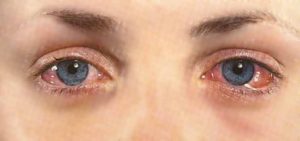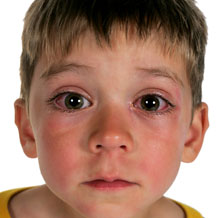 The conjunctiva is a clear membrane that is the tough, leathery outer coat of the eye. The white of the eye actually lies behind the conjunctiva. The conjuctiva has many small blood vessels and it serves to lubricate and protect the eye while the eye moves in its socket.
The conjunctiva is a clear membrane that is the tough, leathery outer coat of the eye. The white of the eye actually lies behind the conjunctiva. The conjuctiva has many small blood vessels and it serves to lubricate and protect the eye while the eye moves in its socket.
When the conjunctiva becomes inflamed, this is called CONJUNCTIVITIS. Conjunctivitis can have many causes, such as bacteria (as in “pink eye”), viruses, chemicals, allergies, and more. In many cases it is difficult to determine the primary cause for the inflammation. One of the most common is BACTERIAL CONJUNCTIVITIS.
BACTERIAL CONJUNCTIVITIS is associated with swelling of the lid and a yellowish discharge. Sometimes it causes the eye to itch and a mattering of the eyelids, particularly upon waking. The conjunctiva appears red and sometimes thickened. Often both eyes are involved.
The bacteria most commonly at fault are the Staphylococcus, the Streptococcus, and H. Influenza. This disease is very contagious, and can be easily transmitted by rubbing the eye and then infecting household items, such as towels or handkerchiefs. It is common that entire families become infected.
Conjunctivitis can be directly cured with treatment. Usually antibiotic drops and compresses ease the discomfort and clear up the infection in just a few days. In a few cases, the inflammation does not respond well to the initial treatment with eye drops. In those rare cases a second visit to the office should be made and other measures undertaken. In severe infection, oral antibiotics are necessary. Covering the eye is not a good idea because a cover provides protection for the germs causing the infection. If left untreated, conjunctivitis can create serious complications, such as infections in the cornea, lids, and tear ducts.
Certain precautions can to taken to avoid the disease and stop its spread. Careful washing of the hands, the use of clean handkerchiefs, and avoiding contagious individuals are all helpful. Little children frequently get conjunctivitis because of their poor hygiene.
Pink Eye
 Pink eye irritates the thin, clear layer covering the eyeball and part of the eyelid (the conjunctiva). It is often caused by a virus or bacteria.
Pink eye irritates the thin, clear layer covering the eyeball and part of the eyelid (the conjunctiva). It is often caused by a virus or bacteria.
What You Need To Do:
If you think you or your child has pink eye, you should see a doctor immediately. Wash your hands to prevent it from spreading. The affected person should stay home from work or school until the eye is better.
Why It’s Important:
Pink eye is very common, and can be very contagious.
Symptoms
The conjunctiva is a thin membrane containing tiny blood vessels and produces mucus to coat and lubricate the surface of your eye.
When the conjunctiva becomes irritated or inflamed, the blood vessels become larger and more prominent, making your eye appear red. Conjunctivitis may occur in one or both eyes. Symptoms include:
- red eyes
- swollen, red eyelids
- watering eyes
- soreness or itchiness
- excess mucus and crusty eyelashes when you wake up
- hazy vision due to mucus
- the feeling that something is stuck in your eye
Treatment
The treatment for pink eye depends upon the particular underlying cause.
If you have a bacterial infection, your doctor may prescribe antibiotic eyedrops or ointment, which should clear the infection within several days.
There is no treatment for viral conjunctivitis. It will take 7-10 days to go away on its own.
Allergic conjunctivitis may respond to treatment for the underlying allergies.
If the conjunctivitis is caused by allergies, irritants, or a virus, you can use cool compresses on the eyes and artificial tears to reduce discomfort.
If your condition is severe, your doctor may prescribe topical steroid to reduce the discomfort from inflammation. In severe allergic cases, non-steroidal anti-inflammatory medications and antihistamines may be prescribed.
If symptoms persist for an extended period of time after treatment, you should tell your doctor. Several eye diseases cause red eyes, some of which can lead to blindness unless diagnosed and treated.
Causes/Risk Factors
Infectious conjunctivitis, whether bacterial or viral, can be quite contagious.
Good hygiene can help prevent the spread of conjunctivitis.
- Avoid re-using handkerchiefs and towels to wipe your face and eyes.
- Wash your hands frequently
- Keep your hands away from your eyes
- Properly clean your contact lenses
- Replace any eye cosmetics regularly.
Viral infection is the most common cause of conjunctivitis. This same virus produces the symptoms of a common cold. Symptoms of conjunctivitis can last from one to two weeks and then will disappear on their own.
Bacterial infections, such as staphylococcus or streptococcus, cause a type of conjunctivitis that produces considerable amounts of pus. Some bacterial infections, however, are more chronic and may produce little or no discharge except for some mild crusting of the eyelashes in the morning.
Infectious conjunctivitis, whether bacterial or viral, can be quite contagious. Practicing good hygiene can help prevent the spread of conjunctivitis if you are infected. You should avoid re-using handkerchiefs and towels to wipe your face and eyes. You should wash your hands frequently and keep your hands away from your eyes. Properly clean your contact lenses and replace any eye cosmetics regularly.
Allergic conjunctivitis is not infectious or contagious. It occurs when the body is exposed to materials that cause an allergic reaction, such as pollen or dander, and is often seasonal.
(Information provided from Einstein Medical, Inc. and the American Academy of Ophthalmology)
